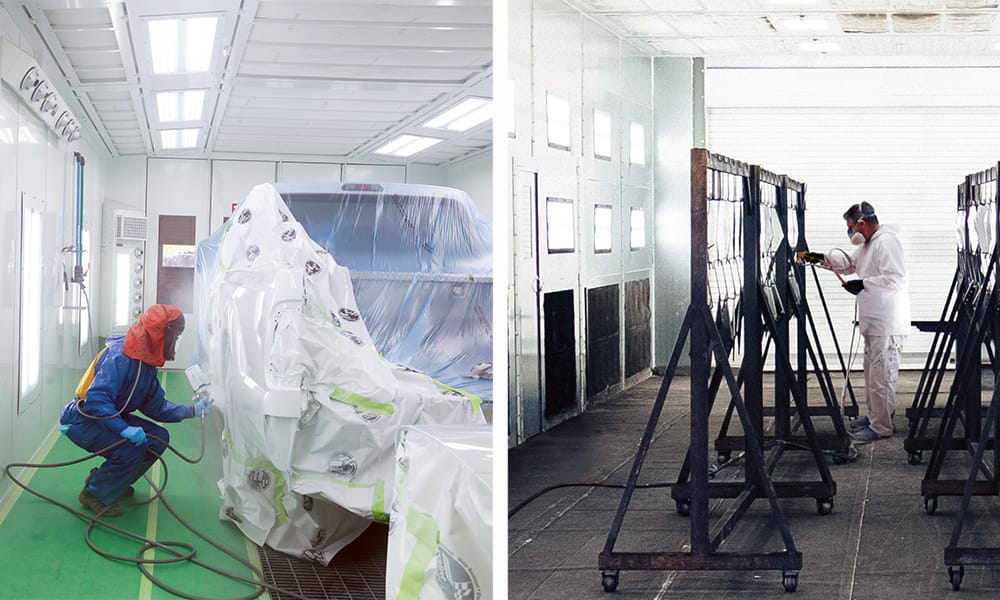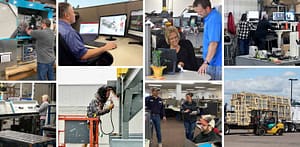
Paint booths are controlled environments for paint application, designed to contain hazardous vapors and provide a safer, healthier environment for painters.
Understanding the components of paint booth design and what purpose they serve is key to maximizing your spray booth’s performance. Here is a look at the most common components of paint booth design:
The walls of paint booths are either single-skin or dual-skin. Both have advantages in terms of quality and cost.
Single-skin panels are strong and rigid, offering cost savings without compromising quality. Cleaning the interior walls of a single-skin spray booth is easy, as the exterior flanges offer a smooth interior surface.
Dual-skin panels provide a smooth fit and finish for a stronger, longer-lasting paint booth. They are insulated to decrease noise and ambient heat outside of the spray booth while keeping heated air inside the cabin.
White pre-coated walls are typically standard with dual-skin booths and may be an option on single-skin booths. White walls increase the reflectability of the lights, making it easy to see what you are painting.
A frequently overlooked component of paint booth design is the spray booth doors. They are essential to the performance of the spray booth and the quality of the finish.
Product doors allow vehicles, parts and products to enter the paint booth for spraying. The type of product door included on a paint booth is determined by whether or not the booth will be pressurized.
Discussions on paint booth pressure center around whether the spray booth is under negative or positive pressure relative to the outside environment. With positive pressure, dirt and debris cannot enter the working chamber and soil the object being painted. Meanwhile, negative pressure prevents emissions and volatile organic compounds (VOCs) from entering the room adjacent to the working chamber.
Non-pressurized paint booths feature filtered product doors. The set of intake filters prevent contaminants from entering the paint booth. Solid doors are used on pressurized paint booths, as air enters the booth through a filtered intake plenum.
Available in galvanized steel, aluminum and fabric, roll-up doors are another solution for enclosing pressurized paint booths.
RollSeal Doors from Global Finishing Solutions (GFS) control contamination and airflow between bays. These doors are most useful when there are space restrictions or when included in a Side-Load Finishing System. They use a triple-layered fabric and airtight seal to prevent overspray from escaping the paint booth. Air between layers of the fabric helps maintain desired heat levels inside the spray booth to meet cure temperature requirements.
Personnel doors give painters quick and easy access to the booth. The door can be located on either side of the paint booth. Observation windows may also be an option on personnel doors.
Located at the front or top of a pressurized paint booth, an intake plenum is a mechanism through which air is introduced into the booth. Air entering the spray booth through the intake plenum may flow parallel to the floor or downward from an overhead plenum at the top of the chamber. The intake plenum is designed with high-efficiency paint booth filters to remove dust and dirt before it enters the spray booth.
The intake plenum may be vertical, located at one end of the paint booth. Or it may be horizontal, using part or all of the ceiling inside the paint booth as an aperture. In cross draft spray booths, the intake plenum is located at the front of the enclosure. In downdraft, semi-downdraft and side downdraft spray booths, the intake plenum is located in the ceiling.
An exhaust plenum is a mechanism through which air is exhausted from a paint booth. The exhaust chamber includes a filter system that captures particles before they enter the atmosphere. An exhaust fan draws air out of the working chamber in the paint booth and pulls it through the exhaust filters and exhaust chamber. Air then passes through exhaust ducting to the outside.
In cross draft and semi-downdraft paint booths, the exhaust plenum is located at the rear of the spray booth. In side downdraft paint booths, filtered exhaust plenums are located on both sides of the spray booth.
When air reaches the floor in downdraft paint booths, it is exhausted through a filtered exhaust pit. The pit may consist of one, two or three rows. It is considered ductwork and must be designed based on the airflow requirements of the paint booth. The exhaust plenum is located at the rear of the booth or on each side of a downdraft spray booth.
The primary purpose of exhaust filtration is to protect a paint booth’s fans, stack and plenum from overspray contamination, without slowing airflow. Exhaust filters must hold enough paint to avoid constantly replacing the paint booth filters. They are located in the plenum at the back of the spray booth, in the pit or in the side downdraft exhaust chambers.
Included with all GFS paint booths, GFS Wave exhaust filters have a holding capacity of 4.4 pounds. Paint-laden air is captured across the surface and within the depth of the media. This extends filter service life and reduces operating costs. GFS Wave exhaust paint booth filters are useful for a variety of paints and a wide array of spray applications, from clear coats to high solids.
Air that is exhausted from a paint booth must be replaced. If replacement air is not pulled directly from a building, it can be pulled from the outside and filtered through an air make-up unit.
An air make-up unit allows for temperature control in a paint booth during coating application and curing. AMUs maintain a constant, leaving-air temperature regardless of the incoming, outdoor air temperature. They replenish equal amounts of fresh air for every cubic foot of air exhausted.
With an AMU, conditioned, filtered air is supplied to the paint booth. There is no need to draw air from the facility, which improves working conditions and lowers operating costs.
There are several styles of differential pressure gauges available to measure exhaust filter loading. Also known as a draft gauge, a manometer is included in all GFS industrial spray booths.
A manometer is the most commonly used “dirty filter” indicator. It indicates when paint filters are loaded and need replacement. Replacing intake and exhaust filters regularly is one of the simplest things for the cleanliness and efficiency of your paint booth.
Clogged or overloaded filters hinder proper airflow through the paint booth. This can cause dust to enter the paint booth and overspray to recirculate, adversely affecting the quality of your paint job.
Some applications and processes may require monitoring devices to be upgraded to a photohelic or magnehelic gauge. The GFS Parts & Filters department can determine what type of monitoring is needed for your spray booth.
The better you understand the components of paint booth design, the more equipped you will be to maximize its efficiency. GFS has an experienced team of technical experts ready to assist you throughout the lifespan of your equipment.
One of the best ways to highlight your business is through a story that you can share across your online platforms. It humanizes your business and shows that your business can make a meaningful impact. Your testimonial would be used as a project profile on the GFS Booth Blog and can be shared on your website and/or social media channels.
Complete this form and we’ll be in touch to showcase your company.

Shop a variety of GFS aftermarket products, including booth protection products and mobile accelerated curing units. And enjoy the convenience of fast and free ground shipping throughout the contiguous United States.

Located at GFS’ headquarters in Osseo, Wisconsin, the Center for Excellence is an innovative facility featuring an automotive refinish training center, as well as a separate space dedicated to technical product training.

GFS is continuously searching for talented, ambitious individuals to join our team. We aim to provide our employees with every opportunity to make an impact on the company and find their niche along the way — weather in a production, field services or an office position.